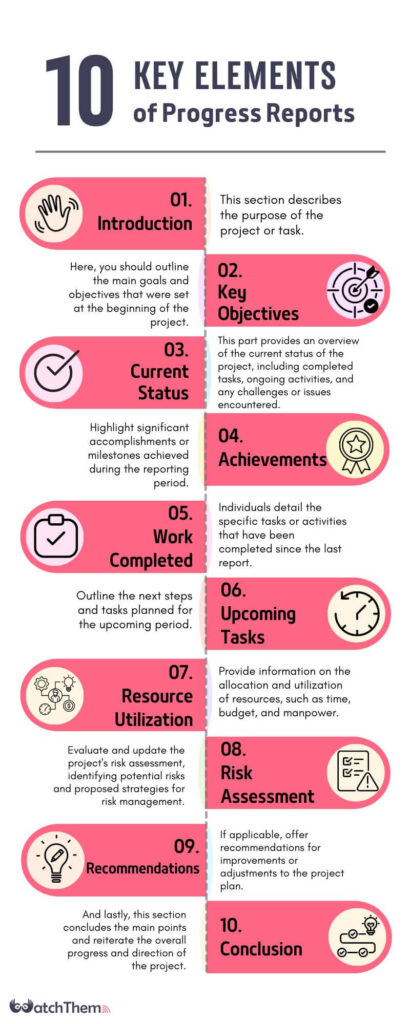Page Contents
Whether you’re a student, a worker, or even a digital marketer, chances are you’ve encountered situations where you had to create a progress report or assess one. But what exactly is this report?
A progress report is a document that provides an overview of the current status and advancements of a project, task, or individual’s work. It typically includes key metrics, achievements, challenges faced, and the overall progress toward established goals.
If you’re a digital marketer or a website owner, you especially will benefit from a professional progress report. When it comes to conversion rate optimization and revenue increase, nothing beats a well-written report to give you a clear understanding of the journey you’re on.
In this guide, we’ll elaborate more on the importance of progress reports, how they can benefit you and your business, and how you can write the perfect report. So, let’s start!
What Is a Progress Report
As we’ve already mentioned, a progress report is a document or communication that provides information about the progress of a project or task. It includes the achievements, challenges, and even a future forecast, and is one of the best data collection methods.
It is typically prepared at regular intervals and is used to update stakeholders, team members, or supervisors on the progress of a specific initiative. Progress reports are used to share insight on the status of projects, and are necessary in every field.
The content of a progress report may vary depending on the context, but common elements often include:


- Introduction: This section describes the purpose of the project or task.
- Key Objectives: Here, you should outline the main goals and objectives that were set at the beginning of the project.
- Current Status: This part provides an overview of the current status of the project, including completed tasks, ongoing activities, and any challenges or issues encountered.
- Achievements: Highlight significant accomplishments or milestones achieved during the reporting period.
- Work Completed: Individuals detail the specific tasks or activities that have been completed since the last report.
- Upcoming Tasks: Outline the next steps and tasks planned for the upcoming period.
- Resource Utilization: Provide information on the allocation and utilization of resources, such as time, budget, and manpower.
- Risk Assessment: Evaluate and update the project’s risk assessment, identifying potential risks and proposed strategies for risk management.
- Recommendations: If applicable, offer recommendations for improvements or adjustments to the project plan.
- Conclusion: Lastly, this section concludes the main points and reiterates the overall progress and direction of the project.
Why Do Progress Reports Matter
In general, the importance of progress reports lies in the fact that they keep everyone involved in a project on the same page. They serve as a way to communicate what has been accomplished, what’s currently happening, and what’s coming up next. This helps team members, managers, and stakeholders stay informed about the project’s status and direction.
Additionally, progress reports provide a means for identifying and addressing challenges. By openly discussing any problems or obstacles encountered during the project, the team can work together to find solutions. This proactive approach helps prevent issues from escalating and ensures that everyone is aware of potential risks.
Regular progress updates also promote accountability. When team members know that their contributions are being tracked and reported, it encourages a sense of responsibility and motivation.
Moreover, these reports contribute to effective resource management. They allow for a review of how time, budget, and other resources are being used. By having this data, managers and stakeholders can manage their resources effectively.
Also Read: What Report Provides Data on How Specific Sections of a Website Performed
Top Tips for Creating Perfect Progress Reports
Knowing the definition of progress reports is one thing, learning how to create the perfect one is another. A well-written report will ensure that your team is on the same page, the issues and risks are addressed, and you’re moving towards the same goals.
Here are some top tips to help you create perfect progress reports:
#1 Clarity and Conciseness
Ensure that your progress report is clear and easy to understand. Use straightforward language to convey your message, avoiding unnecessary jargon or complex terms. Clearly state the main points and key accomplishments.
#2 Focus on Key Achievements
Highlight the most significant achievements since the last report. Emphasize how these accomplishments contribute to the overall goals of the project. This helps stakeholders and team members quickly grasp the positive aspects of the progress.
#3 Use Professional Tools
Using accurate and detailed data in your report is crucial. Make sure to use web analytic tools and similar platforms to gather precise data about your progress and achievements.
#4 Address Challenges and Solutions
Make sure to acknowledge any challenges or issues encountered during the reporting period. Be transparent about obstacles, but also provide insights into how these challenges are being addressed or handled.
#5 Tailor to Your Audience
Consider your audience when creating reports. For example, progress reports for students should be different from a product owner’s report, because their audience is different.
As you see in this progress report example, the audience is key. So, make sure to always take it into consideration!
#6 Consistent Format and Structure
Maintain a consistent format and structure for your reports. This helps readers easily navigate the document and find the information they need. Use headings, subheadings, and a logical flow to organize your content.
You can also use a progress report template to help you create the perfect report that is clear and easy to navigate.
#7 Timely and Regular Updates
Progress reports are not a one-time thing, and they won’t benefit you unless you have a regular schedule for them. Make sure to keep stakeholders informed at predictable intervals. After all, everybody loves weekly progress reports!
When Is the Best Time to Create a Progress Report
It all depends on the schedule and timelines of your project or task. In general, it’s a good idea to create progress reports at regular intervals, like weekly, monthly, or quarterly. This allows for a consistent and organized way to track how things are going.
Creating a progress report at regular intervals helps everyone stay updated on the project’s status.
For example, If you’re working to enhance a website’s performance, a monthly progress report could be suitable. This report might highlight achievements such as increased website traffic, improved page loading speed, and enhanced user engagement.
However, certain tasks might require weekly progress reports, so it all depends on the project you’re working on. The key is to choose a schedule that makes sense for your project and keeps everyone well-informed.
FAQs on What Are Progress Reports
In the following, we’re going to answer some frequently asked questions. So, if you have any questions left, this part is for you!
Q1. What Is the Structure of a Progress Report?
A progress report often includes an introduction, key objectives, current status, achievements, completed work, upcoming tasks, challenges, resource utilization, and risk assessment. The structure provides a comprehensive overview of the project’s status and future plans.
However, the structure may be different based on the project you’re working on.
Q2. What Is a Progress Report in CRO?
When it comes to the context of CRO, a progress report is a document or communication that provides updates on the efforts and results related to improving the conversion rate of a website or online platform.
This report typically includes information on experiments conducted, changes implemented, key website performance indicators (KPIs), and the impact on user engagement and conversion metrics.
The report aims to provide insights into the effectiveness of optimization strategies, highlight successes, and address any challenges encountered in the process of enhancing the conversion rate.
Conclusion
Understanding and effectively utilizing progress reports are crucial for individuals and businesses across various fields. A well-structured progress report serves as a powerful communication tool, providing a comprehensive overview of achievements, challenges, and upcoming tasks.
For digital marketers and website owners, the relevance of progress reports in the realm of conversion rate optimization (CRO) cannot be overstated. These reports offer a detailed insight into the impact of optimization strategies, experiments conducted, and changes implemented on key performance indicators (KPIs) and user engagement.

